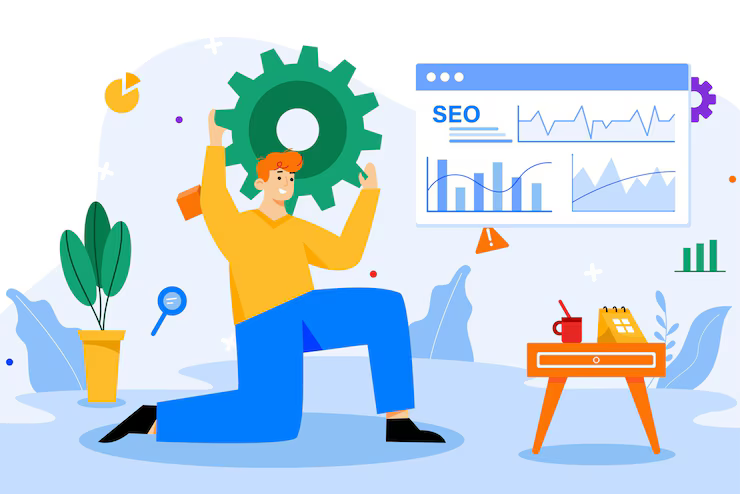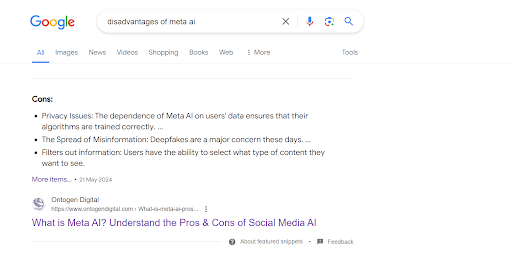28 June 2024 |
By - Sudha Mariappan

As a digital marketing agency, we need to be constantly aware of SEO practices to put our customers at ease. With all of our other services, we provide SEO services as well.
But as a businessperson, you need to have common knowledge on how to create an On-page SEO, which is quite easy to do by yourself.
In this blog, you’ll learn the basics of an On page SEO and how you can use them for better visibility of your website page.
What is On-Page SEO?
On-page SEO is the face of your website. And one of most important factor of Search engine optimization
It is the practice to increase its visibility in the Search Engine Results Page (SERPs) and drive organic traffic at the level of individual pages on a website.
On-page SEO deals with optimization elements on the website itself, that’s why it’s the face of your website.
It is not like off-page SEO, which deals with external factors like the number of backlinks. Off Page SEO covers your website’s content, the background HTML source code, and user experience aspects which happen in the background.
A strong on-page SEO strategy will let the search engines understand the intent and relevance of your pages, far beyond simplistic keyword stuffing.
It's all about giving your user a holistic experience, making your page in tune with search engine algorithms and user expectations. Therefore, effective on-page SEO will go a long way in growing the ranking of the site and user findability.
Search engines like Google look at many on-page factors to find relevance between a page and the user's query. This delivers the coherence of meta tags, the quality of content, keyword usage, proper URL structure, images, internal links, etc.
Optimizing these elements can be rather useful for you to bring a webpage's rankings high within the SERPs and, therefore, attract more traffic.
Download Now: Free On-Page SEO Checklist
Optimizing Your Website’s Titles and Headings:
When the on page SEO is the face of your website, optimization of titles and headings is the real foundation of on-page SEO. It significantly affects how search engines and users perceive your content.
The title tag is often viewed as the most important on-page SEO element and is actually is the very first view for your users on the search engine result pages.
That is why it should be descriptive, short, and include just the primary keyword. You can draw a massive audience just by using an effective title keyword because it not only draws in clicks but can also tell the right story about what's on the page.
Proper structuring of headings, from H1 to H6, is vital for your audience to have their eyes on your page.
Imagine if your website ended up with poor structure, the bounce rate would increase insanely. Therefore, prestructure the content so that users and even search engines find it much easier to get around.
Usually, the H1 tag represents the main heading for the page and shall carry the main keyword, emphasizing the overall topic of the page.
Further H2 and H3 headings should then be used to break down the content into proper sections and subsections, which allows your readers to get an overview of the main points while navigating easily through the content.
This will also improve the hierarchy and relevance of the information on the page easily from search engines.
An optimized title and headings will do a lot more than raise your ranking in the search engines; this will help in enhancing user experience through clarity of structure of content.
This enhances further engagement, decreases bounce rates, and maximizes conversion rates.
Crafting Compelling Content Your Audience would choose:
Attention-grabbing content is the backbone of on-page SEO.
It’s your great content that informs, entertains, and serves your audience, prompting more visitors and also a longer stay and further on-site and concluding with desired actions.
The search engines identify and further give the first place to such types of content, which assures a great user experience by very effectively answering users' needs and questions.
Comprehensive keyword research forms the first step toward developing engaging content. This basically means understanding what users are looking for and using those keywords naturally within the content to assist in their search intent.
For example, our blog based on Meta AI ranked on top of the google search results just by organic on-page SEO.
By typing the keyword, “Disadvantages of Meta AI”, you’ll get to see that the google search results have returned the following results.

Moreover, you have to make sure that the content is well-structured with regard to readability. Add subheadings, bullet points, and relevant images to break up the text to be more varied in your content instead of being monotone.
Equally important in on-page SEO is the length and depth of the content. Although there is no one-size-fits-all approach, generally longer and more comprehensive content tends to rank well in search results since it will more likely elaborate on a topic.
However, it is important to note that this should be balanced properly so that the content remains engaging and relevant throughout its length, as mentioned above.
You can include multimedia such as images, videos, detailed infographics, etc. It’ll greatly enhance User Interface appeal, and expand user engagement. Simultaneously, these elements will increase the attractiveness of content and pave more ways to optimize alt text, captions, and file names.
Download Now: Free On-Page SEO Checklist
Images and Internal Linking for Better Optimization:
Image optimization and internal linking are the two most essential elements of on-page SEO, which will determine your success or doom of your website in terms of performance and user experience. It is as important as adding keywords to your website.
Well-optimized images will add appeal to the page, lighten your website’s load time for easy use, and provide additional context to the search engines. Internal linking helps in creating a clear structure and rank for the website.
For better reach of your website, you need to add alt text of descriptive file names to optimize your website. It shows what an image refers to or has been used for by the search engines.
Fortunately, it also enhances the accessibility features available for visually impaired people.
Also read: What is SEO? Check out these valuable SEO Tips for Beginners
It will also reduce load time by applying the right image formats and image compression, by this you’ll be rewarded by a better user experience, which means a higher ranking on search engines.
Internal linking is linking to other pages within a website. This would guide the search engines in the indexing of the site by distributing links around pages while creating a good structure of the site.
Internal links should be created and distributed in such a manner that they intelligently guide users to other relevant content of yours, which would motivate them to see more pages within a site. This could result in higher engagement, long user sessions, and reduced bounce rates.
An effectively strategized and executed internal linking plan will also further assist in topic relevance and authority by signaling to search engines that the important and related existing pages within a site are. This improves the visibility and ranking for these pages within search results.
Keep your Content Updated and Fresh:
Another often overlooked but very critical aspect of on-page SEO is keeping the content updated. When your content is stale and not updated, the visitors will decrease rapidly.
Search engines can be very loyal to fresh and relevant content since it can make sure to be appropriate and up to date information for users.
Refreshing the content from time to time helps search engines know the site is active, and also improves the user experience with relevant, updated information.
Content refresh can be anything from revisiting earlier posts and pages of information to update, refreshing, and correct outdated or inaccurate details.
This may include updating the statistics with new information, including fresh examples or case studies, and revising content when industry trends or best practices change.
Also, the process of updating the content presents the opportunity for re-optimization with current and relevant keywords and trends in search.
Another important part of content refresh is the tracking and improvement of the technical SEO elements related to a site, which includes fixing broken links, enhancing site speed, and making sure that your site is mobile friendly.
Using these factors can greatly impact your site's performance and user experience thereby increasing your visibility and ranking in search results.
Moreover, with regular updating of content and technical SEO elements, problems stay away and they would be detected less at the correct time.
For example, duplicate content, or content with no proper relevancy can cause errors. In this situation, you can use a webmaster now known as Google search central who has the resources to get your website on top, and who is always virtually on top of things to secure the relevance, competitiveness, and even user-friendliness of your site by keeping it updated.
Download Now: Free On-Page SEO Checklist
If this information helps you to know about SEO practices, and if you’re interested in our services, you are always welcome to reach us at info@ontogendigital.com. If you’re interested in more of our blogs, subscribe to our blog channel at Ontogen Digital website.